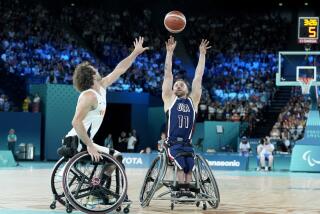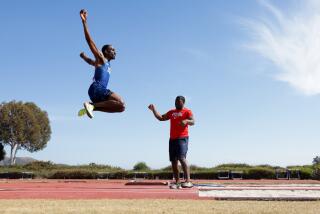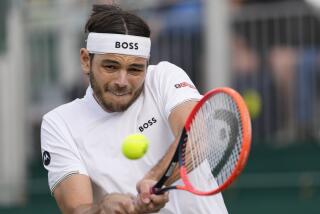Wheelchair Tennis Is Ready to Go It Alone
Sometimes a manâs greatest accomplishment can be to make himself dispensable. By that measure, Brad Parks is well on his way to a remarkable achievement.
His baby, wheelchair tennis, is all grown up now and ready to proceed on its own. From its humble beginnings on a glass-strewn court in Griffith Park 21 years ago, it has spread around the world, with tournaments in 19 countries. Recognition. Acceptance. Sponsorship.
Establishment.
Beginning next year, the United States Tennis Assn.--the same group that runs the U.S. Open and national tennis programs--will take over most of the responsibilities of Parksâ National Foundation of Wheelchair Tennis (NFWT) in the United States. The International Tennis Federation will handle matters abroad. Wheelchair tennis is no longer so dependent on individual efforts.
âA couple of years ago, if something would have happened to me, I could see the organization of the sport suffering quite a bit,â said Parks, whoâs from San Clemente. âItâs way beyond that now. Thatâs important.â
Parks, 40, has spent half his life bringing the sport to this level. After he broke his back in a skiing accident, he helped create the rules for wheelchair tennis--which are essentially the same as regular tennis except the ball can bounce twice before it is returned--and he formed the NFWT in 1980.
Since 1981, Parks has played the acceptance game by the rules of the USTA--lots of meetings, lots of bureaucracy. Thatâs the price you pay to join the big time. He went to conventions. He networked and he schmoozed.
The USTA formed a subcommittee on wheelchair tennis and then, two years ago, a committee. The takeover will become official on Jan. 1.
âWheelchair tennis has become a fully realized sport,â Parks said. âWe are part of the Paralympics, which is the Olympics of wheelchair sports. Now we are a full committee and we are a part of the USTA. Weâre just going to grow.
âFive years from now, itâs going to be incredible to see where wheelchair tennis is. Itâs got to be tremendous, the growth and the changes that will take place because of our involvement with the USTA.â
Already wheelchair tennis has grown to 12,000 participants worldwide, Parks estimates. This countryâs showcase event, the U.S. Open Wheelchair Tennis Championships, drew a field of 260 this week to the Racquet Club of Irvine.
âThe first year, we had 80 people, probably,â Parks said. âThey were probably the only 80 wheelchair tennis players in the world. This year, youâve got the 260, but theyâre the people who are the best players in the world.â
Whether itâs a pastime or a way of life, thereâs an opportunity that didnât exist before.
âIt really is very lucky for anybody to fill their passion with their work,â said Steve Welch, a wheelchair tennis professional and a member of the national wheelchair basketball team. âMost people, their work becomes their passion. Itâs a dream.â
Sharon Clark, the unseeded surprise finalist in the womenâs draw, received a tennis racket from her father after a car accident broke her back and put her in the hospital for three months at age 17. She would go outside and hit balls against the wall while recovering.
Clark went back to school, and after she received her masterâs degree in comparative literature from San Francisco State in 1995, she decided to take her shot at the tour.
âEventually, I want to teach full-time,â said Clark, now 29. âI just figured I should play while Iâm still young.
âTennis has been great. Before I was in the car accident, I played a lot of sports. I missed that.â
Opportunities. Thatâs all Parks wanted. Accidents may take away peopleâs ability to walk, but it shouldnât stop them from living a full life and enjoying sports.
âWhen I think about my first thoughts of what I wanted to accomplish when I started this organization, it was just get people to play tennis, really,â Parks said. âBut this [tournament] is sort of the pinnacle of that, to have something like this.â
The NFWT will maintain some duties, including the operation of the wheelchair U.S. Open and a sports camp in Mission Viejo. Parks would like to see some improvements to the tournament, such as a larger purse than the current $10,000, more scoreboards and more umpires.
But he has reached the point of cosmetic touch-ups. The foundation is there.
âItâs becoming a real sort of happening, a festival,â Parks said. âPeople from all over wheelchair sports are starting to come here to meet, to watch the matches and be a part of it. Itâs pretty neat, because I can remember back to when it wasnât such an accepted sport and we had such a long way to go before we were an accepted sport. Itâs pretty fun to see it now.
âWhen we first started, youâd start to talk to somebody, youâd start talking about things that you were doing and maybe wheelchair tennis would come up. Most people would go, âWheelchair tennis? Youâve got to be kidding me. You play tennis in a wheelchair?â â
No kidding. And now, all these years later, no doubt.
More to Read
Go beyond the scoreboard
Get the latest on L.A.'s teams in the daily Sports Report newsletter.
You may occasionally receive promotional content from the Los Angeles Times.










